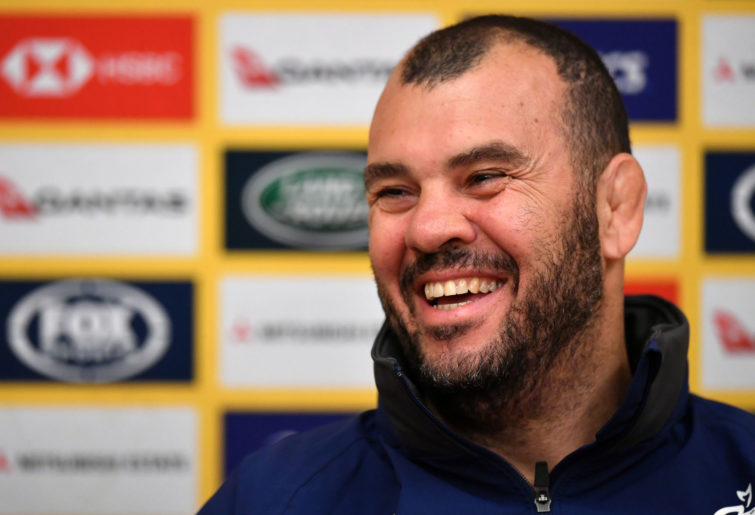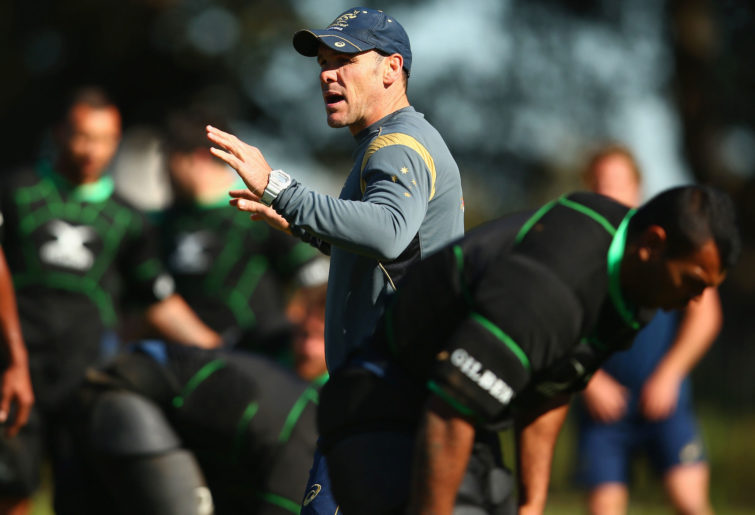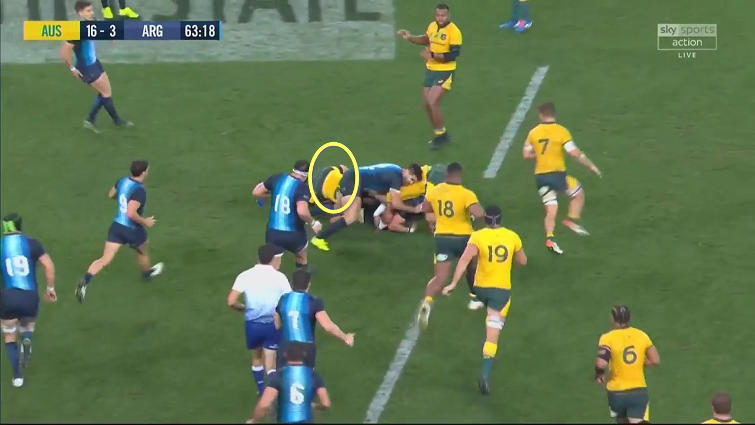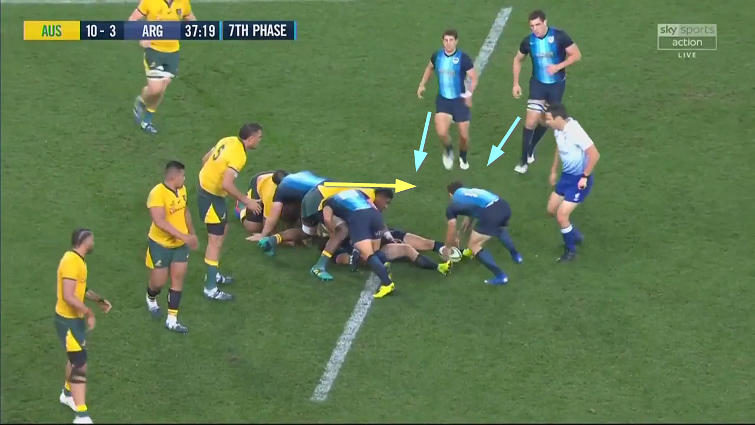They say that a draw is like kissing your sister, an underwhelming experience replacing what would otherwise have been a great pleasure.
If that’s the case, the Springboks certainly looked a lot happier with the result in Wellington than their downcast New Zealand counterparts immediately after the final whistle.
South Africa had good reason to be cheerful. Under the stewardship of Rassie Erasmus, they have fought the All Blacks to a standstill in their last three encounters; winning 36-34 last season at the Cake Tin before losing by the same two-point margin (30-32) in the return game at Loftus Versveld. The symmetry of those results was maintained absolutely by Saturday’s 16-16 draw – at present, there is not a sliver of choice between the two sides.
The Wallabies and Pumas provided another version of the sibling-kissing syndrome at the Suncorp, with Australia’s 16-10 victory avoiding the Rugby Championship’s version of a wooden spoon.
Nonetheless, in the context of Australia’s defeat by the South Africa ‘B’ team on the previous weekend, the Wallaby coaches will take a lot of concrete positives from the performance of their charges at the Suncorp.
That applies particularly on the defensive side of the ball, where they managed to restrict their opponents to ten points or less for only the fourth time in in the past three seasons.

(Photo by Dan Mullan/Getty Images)
Shelling out points with reckless generosity has been a regular feature during that period, with Australia conceding an average of over 28 points per game in 2017 and 25 one season later. Against New Zealand, the tale of the tape has been even worse, with the Wallabies giving up an average of 37 points to their neighbours from across the Tasman.
Fox analyst Rod Kafer attributed the improvement against Argentina to Australia’s willingness to reduce their line-speed in order to keep line integrity:
“Eighty per cent of all tries are scored off line breaks and there’s a relationship between rushing out of the line and missing tackles. So, if you put line speed on, you’re actually more likely — if you miss — to give a line break.
“So, the Wallabies just used tonight — the first time I’ve seen it under Nathan Grey’s coaching — a much more passive line speed. We call it soaking — you soak up the opposition, you let them run at you, show them the outside and then you tackle them.”
It is doubtful that many, if any elite defence coaches would agree with Rod Kafer’s philosophy, although it does fairly reflect Australia’s difficulty in implementing the principles behind rush defence consistently under Nathan Grey since the last World Cup.
In reality, the match against the Pumas represented a sea-change in the Wallabies’ will to contest the breakdown. That is a much more definite explanation for the improvement in the Australian defence between the first and second weeks of the Rugby Championship, and it is an aspect of the game open to mathematical analysis.

Wallabies defence coach Nathan Grey. (Photo by Mark Kolbe/Getty Images)
Bill James was the first to introduce mathematical and data-based analysis to baseball in the US in the form of his Baseball Abstracts, first published in 1977. It took the better part of two decades for James’ methods to be accepted by the mainstream of the sport before he was finally hired in 2003 by an avid reader of his work, Boston Red Sox owner John Henry.
The Red Sox promptly broke the 86-year-old ‘curse of the Bambino’ the following season, the first time they had won a World Series since 1918. In the fourteen seasons James was with the club, they won four World Series, and the wound caused by Babe Ruth’s sale to the New York Yankees at the end of World War I was healed, even if the scar tissue always remained visible.
Compared to baseball, professional rugby and the analysis derived from it is still in its infancy. The statistics available through media outlets varies in value, pitched anywhere on the spectrum between useful and misleading.
The stats for breakdown efficiency are a case in point. They tend not to represent the effectiveness of defensive teams who use high or ‘choke’ tackles to turn over the ball before the ball ever gets to ground, nor do they count the number of times where the defence slows the ball down and disrupts the following phase of attack.
The free-to-air stats show South Africa winning their ruck ball at 98.7 per cent (76 of 77 rucks) in the first round of the Rugby Championship, and Argentina winning theirs at 95.1 per cent (77 of 81) in the second. Not much of a difference – or so you would think.
When we dig further – much further – below the surface, we see a massive difference between the Australian effort at the breakdown in Joburg and one short week later in Brisbane.
The overall percentage of on-ball attempts increased from 24.7 in the Republic to 38.3 at the Suncorp. The increase in the percentage of successful disruptions and turnovers was even more startling, up from 6.4 per cent to 17.3 in the space of seven days.
It is possible to evaluate mathematically the impact of every player on the field at the breakdown or in post-contact work – in relation to on-ball attempts, pressures and achieved turnovers, in respect of negative penalties given up at the ruck, all framed within the time they spent on the field.
Here are my figures from the game against South Africa:
| Player |
Involvement/turnover |
Adjusted value |
| Michael Hooper |
6/1 |
2.5 |
| Taniela Tupou |
3/1 |
6.09 |
| Folau Fainga’a |
3/0 |
1.23 |
| Isi Naisarani |
3/0 |
0.78 |
| James Slipper |
1/0 |
0.41 |
| Samu Kerevi |
1/0 |
0.25 |
| Dane Haylett-Petty |
2/0 |
-0.75 |
Now compare them to those from the match against Argentina:
| Player |
Involvement/turnover |
Adjusted value |
| Michael Hooper |
8/3 |
5 |
| Isi Naisarani |
5/2 |
3.67 |
| Tolu Latu |
4/0 |
4.55 |
| Taniela Tupou |
4/0 |
3.08 |
| Scott Sio |
4/0 |
1.67 |
| Folau Fainga’a |
2/1 |
1.73 |
| Lukhan Salakaia-Loto |
1/1 |
1 |
| Tevita Kuridrani |
2/0 |
0.5 |
| Samu Kerevi |
1/0 |
0.25 |
| Luke Jones |
1/0 |
-5.71 |
Any score over 3.00 represents a substantial contribution in breakdown defence. Deep analysis is like peeling the layers of an onion. In the process, some expectations are confirmed, others are confounded, and new revelations come to light!
These are just some of the conclusions we could draw from a comparison between the matches:
- Responsibility in Brisbane was more collective, with ten players involved and four different defenders winning turnovers
- The involvement of the front row in support of Michael Hooper is crucial – increasing from 37 per cent in South Africa to 44 per cent of total output at Suncorp
- Effort off the bench, via Taniela Tupou and Tolu Latu, was both productive and disciplined at Brisbane – only one penalty conceded by Luke Jones
- Isi Naisarani was the biggest improver between the two games
- Australia get little or no positive involvement from the following positions: 4, 5 and 6 up front; 9, 10, 11, 14 and 15 behind.
Let’s take a look at some snatches of action to help flesh out the stats. Compared to the examples from the game against the Springboks last week, where the second man was either consumed as a tackler or backed off after the tackle had been made, the attitude of the second man into contact against Argentina was far more aggressive.
Remember Isi Naisarani against the Bokke? Now look at the new, improved version:
There is no hesitation as the big Fijian-born number 8 attacks the ball on the floor in both instances.
The second example also demonstrates the value of low, ‘chop’ tackling to expose the ball-carrier when he goes to ground. Michael Hooper is really very good at executing this technique, and the presence of the tackler on the deck significantly forces the cleanout players to change their angle of entry into the tackle zone:


The tackler getting up directly behind the runner means there is only one side of the tackle zone open for the cleanout, and that allows the jackal to get a foothold over the ball. Here is Hooper again, creating an opportunity for Scott Sio:
He was back up on his feet for a next phase which exemplified the value of a disruption, even when the turnover isn’t completed:
Hooper’s effort at the first ruck means that the ball is uncontrolled, and spits out of the back at the point of release. That, in turn, enables the next tackle to be made ten metres further downfield, allowing Naisarani to attack the ball before the next play is ready to be implemented:

Pumas halfback Tomas Cubelli is still running towards the ruck site as the ball springs loose.
The final screenshot highlights the improvement in the sense of collective responsibility for the breakdown from Joburg, late on in the game:
Hooper nets Cubelli at the base of another creaking Argentine scrum, then becomes the spearhead of a counter-ruck over the top of the tackle ball by four other forwards.
Summary
Can the improvement in Australian defensive play really be attributed to a cunning plan to give up line-speed and ‘soak up’ the Argentine attackers more passively? I doubt it, although the aim to maintain connection with defenders both inside and outside is an entirely legitimate one.
The more concrete reason, opened by a deeper analytical dig, was the heightened intensity and commitment of Wallaby defence at the breakdown. Everybody improved across the board in this respect, and no one more so than Isi Naisarani. For the Australian selectors, he has been the most welcome surprise so far in the Rugby Championship.
Australia still needs to find a number 6 to complement Naisarani and Hooper, but that problem could be solved by the return of either David Pocock, or conceivably Pete Samu, from injury.
The front row also looks increasingly likely to become a Wallaby strength at the forthcoming World Cup. All six all scrummed well, and Scott Sio, Taniela Tupou, Folau Fainga’a and Tolu Latu all offer invaluable support at the tackle – whether in starting roles or off the bench.
It’s not yet a full-blown love affair by any means, and the All Blacks may spoil the party again next weekend – but maybe kissing your sister is not such a bad beginning after all.

































































































